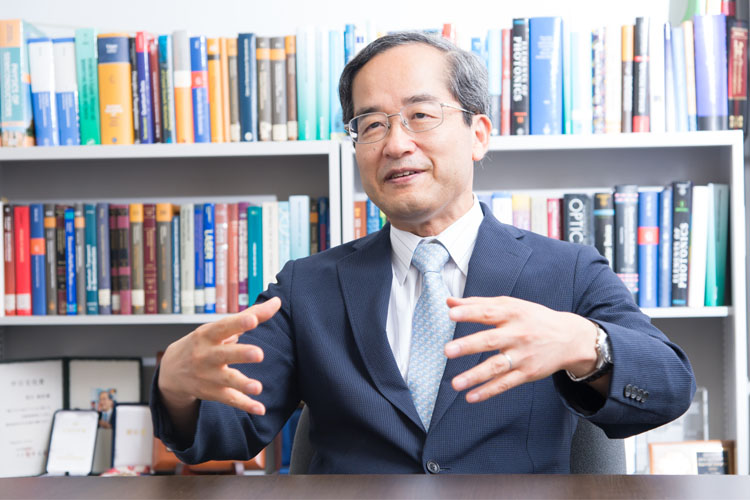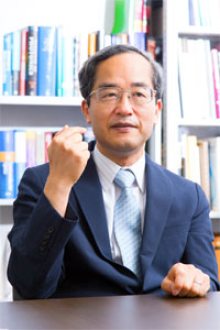- Home
- > Outreach
- > Publications
- > CONVERGENCE
- > LEADER’S VOICE
 LEADER’S VOICE
LEADER’S VOICE
Yasuhiko Arakawa
Create your own path in life, without fearing change

An approach to the central issue of research
involved in that work?
In graduate school, I was involved in research on communication theory, especially in optical communication theory, but when I became a lecturer at the University of Tokyo in 1980 I changed my specialization to device development and set semiconductor lasers as my research theme. While I made that change at the request of the university, I had also wanted to do experimental work, and not just theoretical work after seeing the limits of communication theory. At the Institute of Industrial
Science where I was working, Prof. Hiroyuki Sakaki, an up and coming associate professor at that time, was doing research mainly on electronic devices using quantum effects. Around that time, active research began in the US on thin film laser - that is, the quantum well laser incorporating developments of Dr. Leo Esaki’s work on semiconductor superlattices. That area seemed interesting to me. Then I decided to focus on lasers accompanied by quantum effects. In a quantum well, electrons behave two-dimensionally, but I wondered what would happen if their degree of freedom were changed. This led me to write my paper published in 1982 which proposed the application of the quantum dot and laser.
——Your research became particularly well-known overseas.
For two years beginning in 1984, I joined the laboratory of Prof. Amnon Yariv at the California Institute of Technology. While pursuing theoretical research, we also performed various experiments on quantum well devices. The opportunities to create actual devices in the laboratory was a valuable experience for me. The first paper that I jointly authored with Prof. Yariv in 1984 had an important impact on the world.
Actually, my paper on quantum dot lasers from 1982 was too ahead of its time to attract much attention. Even though people might call it “interesting,” they really meant to say that it “wasn’t mainstream enough of a topic.” However, in the paper that I authored with Prof. Yariv, we
were able to introduce new ideas which I had cultivated about quantum effects to central issues in laser research at that time, including modulation characteristics and spectrum characteristics. Even though it was the same topic, the fact that we came to grips precisely with this central issue was important.
——After all, how one understands the key issue is critical when selecting a research topic, right?
While something may be a key issue, it also has to be new. In my case, I think that it was good that I could show the practical impact of quantum effects. If something is a key issue, then many researchers are already doing it. However, we were able to make a breakthrough by introducing
a new aspect into that.
Toward practical applications of “quantum mechanics”
A silicon interposer incorporating a quantum dot laser was announced in 2014 in the FIRST program [FIRST: Funding Program for World Leading Innovative R&D on Science and Technology]. This realizes
optical information transmission in an optical wiring integrated circuit in a 5mm square of silicon. The threshold current of the quantum dot laser displays little temperature dependency, and the threshold current is almost unchanged even at high temperatures. It is not affected by the heat generated by the integrated circuit. We confirmed very high speed operation of the circuit at temperatures as high as 125°C, which is impossible with conventional semiconductor lasers.
Up to now, the object was long distance communication, but quantum dot lasers are now being applied practically even to this kind of ultrashort distance. There is virtually no doubt that quantum dot lasers will be applied in computing technology in the near future. Of the three
fundamental elements of computers, namely storage, logic, and wiring storage and logic may continue to use electricity, but in wiring, the changeover from electricity to light is only a matter of time. This means the optical communication technology is introduced to the LSI/computer industry with a large market. Silicon photonics utilizing quantum dot lasers play an important role in this paradigm shift of the market.
In fields other than optical communication, high expectations are also placed on quantum dot lasers in a variety of applications, which include ultra-high power lasers, ultra-compact lasers, ultra-low power consumption lasers, optical detection and so on. The quantum dot laser in particular can play an active role as a nanolaser in a variety of areas in the future, including so-called “IoT.” I am extremely happy as an engineering researcher that it is possible to bring one essential property of quantum mechanics, namely the complete discretization of energy, to fruition in this kind of practical quantum dot laser device.
The importance of the mobility of human resources
I feel that the program is further developing the good points of each center, without forcing linkages with industry. This also has the aspect of strengthening the organization to which the WPI center originally belongs, which in the case of MANA means NIMS. For society as a whole, this increases the organizations which are strengthened in that manner, which benefits Japan as a whole.
——And expanding opportunities in Japan as a whole is also important from the viewpoint of developing young researchers?
I feel that it is important to increase mobility in society and create an atmosphere in which people can take advantage of moving to other organizations. If every researcher who joins a certain organization continues to work in the same place through their entire career, this is questionable
from the viewpoint of activation of that organization and society as a whole. Personal growth can be encouraged by changing affiliations and objectives of research.
——You also changed your specialization.
As to why I was able to change my specialization when I found a job in the University of Tokyo, the fact that I had been hired with a permanent contract and managed my own laboratory from the beginning were important. Otherwise, it would have been difficult to change specializations. If the pressure to write a paper in two years is too intense, people will choose the easy way and won’t be able to act boldly. That’s a delicate balance. Also, even though the number of researchers required for one research area is almost unchanged, the number of young researchers entering has increased dramatically because of postdoctoral recruitment programs and such. Both the policy side and the young researchers themselves must be conscious of that risk. If you don’t achieve results within a certain period of time, it is also necessary to have the mentality to transform yourself, for example, by approaching industrial aspects, or by resolutely going abroad, or by changing fields of specialization. Even looking at the US, Germany and other countries, a large number of young people don’t join a research organization after finishing their Ph.D., but, for example, become consultants, or find employment in companies, or grapple with other work. Researchers, with diverse values, must search for their own path in life.
——What are your expectations for MANA in the future?
In particular, I think that MANA has succeeded in good human resources development for young researchers. Not only the results of today’s research, but also the fact that their experience at MANA provides good sustenance for researchers who return to their own countries 5 years or 10 years from now, is also important. They will return to their own countries or go on to their next position with successful experiences and good memories of Japan. That will create something that can be called a MANA network, they will send their own students to Japan, and this will expand and deepen the network with other countries. In the broad sense, this will result in mobility of human resources. That kind of development can be expected.

Director of the Institute for Nano Quantum Information Electronics, Professor / Center Director of the Center for Photonics Electronics Convergence, the Institute of Industrial Science, all units of the University of Tokyo.
Prof. Arakawa completed his Ph.D. specializing in electrical engineering at the University of Tokyo in 1980, became Lecturer and later Associate Professor at the Institute of Industrial Science, the University of Tokyo in the same year, and in 1993, was appointed as Professor at the institute. From 1984 to 1986, he was a Visiting Researcher at the California Institute of Technology. He is presently Director of the Institute for Nano Quantum Information Electronics, Professor / Center Director of the Center for Photonics Electronics Convergence, the Institute of Industrial Science, all units of the University of Tokyo. Among his many awards, he received the Leo Esaki Award in 2004, the Medal with Purple Ribbon in 2009, the Heinrich Welker Award in 2011. He has been President of the International Commission for Optics (ICO) since 2014.

